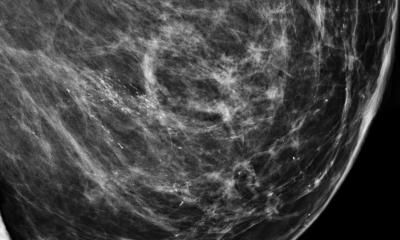Breast brachytherapy
Studies show promise for fast, 5-day therapy for early-stage breast cancer patients
Breast conservation surgery followed by radiation therapy for women with early stage breast cancer has been proven to have the same outcomes as mastectomy. However, conventional radiation therapy requires five daily treatments for 5-7 weeks, a regime that may be logistically difficult for the patient and potentially impossible to undertake if she does not live near a treatment centre.
Accelerated partial breast irradiation (APBI) enables women to complete radiation treatments in just five days. The use of intra-cavity ABPI treatment is increasing in the USA and in Europe. Clinical trial results are proving that the outcomes for low risk breast cancer patients are comparable to traditional treatment and that this is an easier to complete and more acceptable form of radiation therapy for the patients. Radiation oncology departments of hospitals and cancer centres operating at maximum capacity also benefit.
The limitation of ABPI, most commonly delivered by breast brachytherapy, has been the narrow criteria used to select appropriate patients. APBI is not suitable for every woman identified with early stage breast cancer. Eligibility requirements include the criteria that the tumour is no larger than three centimetres, with clear margins of excision, and negative lymph node involvement. Because of the unknown risk of cancer recurrence, the treatment has been limited to women over 45 years. Location of the tumour cavity from the lumpectomy also has been a critical issue, as is the size of the patient's breast, due to concern about radiation to the chest wall and skin toxicity.
Clinical results reported in April and May about clinical outcome findings will enable a broader spectrum of patients to receive this therapy. Age does not appear to be an issue. A group of women who participated in the first clinical trial evaluating the use of MammoSite, the first balloon brachytherapy catheter that received both the USA’s Food and Drug Administration 510-K approval and a CE Mark, have been followed since the trial results were first reported in 2003.
This clinical trial was conducted by the American College of Breast Surgeons. It included 1,440 patients being treated between 2002 and 2004 at 97 hospitals. After three years, only 2.5% of the women had a local breast cancer recurrence, and 89% had good to excellent cosmetic results. After five years, the women who were 31 to 50 years of age at the time of treatment have comparable outcomes to women over 50. The effectiveness of APBI treatment appears to be neutral in age. These results were published online in the Annals of Surgical Oncology, in March this year,
The MammoSite single-entry catheter consists of a balloon that is inflated to the cavity edges of a tumour, and permits a symmetrical radiation dose distribution to be delivered from inside the cavity to the adjacent tissues surrounding the balloon. An estimated one third of all women who otherwise would be eligible for the treatment cannot be treated because their tumour cavity is either too close to the skin tissue or too adjacent to the chest wall with potential damage to the heart.
The approval of two types of single entry-multi-catheter for use in Europe will change this. The difference is that once the balloon is inflated, different radiation doses may be dispensed in each catheter, sparing a potentially damaging dose to skin or the chest wall in very close proximity to the tumour cavity. The use of the SAVI applicator from Cianna Medical of Aliso Viejo, California and the Contura Multi-Lumen Balloon from SenoRx of Irvine, California, enables radiation oncologists to customise effective treatment of even the smallest breasts.
This spring the results of clinical trials for each product were published. Radiation oncologist Sheree Brown MD, and colleagues at the Wellstar Kennestone Hospital in Marietta, Georgia, published their experiences with 41 patients in Brachytherapy. Patients treated over 12 months between June 2007 and May 2008 had comparable outcomes and mild toxicities similar to MammoSite.
Study results of 63 patients treated with the SAVI applicator at the Moores University of California-San Diego Cancer Centre and the 21st Century Oncology private cancer treatment clinic, in Fort Myers, Florida, were equally positive. The researchers presented their findings in April at the American Society of Breast surgeon's annual meeting.
With such clinical trial results, a much greater percentage of women with early stage breast cancer should be able to have this fast, five-day cancer treatment and get on with their lives.
Report: Dorothy M McSherry, i.t. communications
01.05.2009











